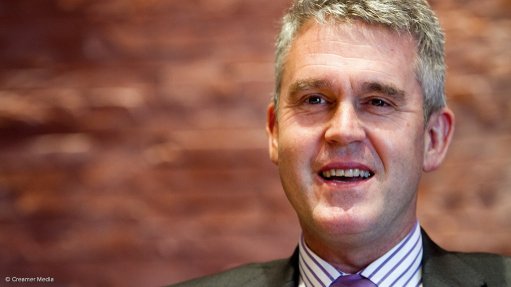
Kropz CEO Ian Harebottle
Photo by: Creamer Media
Emerging plant nutrient producer Kropz, which on Friday listed on the Aim, has raised gross proceeds of about £27.3-million, or about $35-million, before expenses with new UK, South African and international shareholders, as well as existing shareholders.
The net proceeds of the fundraising will be used to complete the upgrade and commissioning of Kropz’s flagship Elandsfontein phosphate project, in South Africa, as well as to define the programme for the development of the company’s greenfield Hinda project, in Ghana.
Net proceeds will also be used to reduce the company’s current debt position.
A dual-listing on the Aim and JSE is on the cards, but this is only expected towards the end of 2019.
With a purely South African rationale in mind, Kropz CEO Ian Harebottle told Mining Weekly Online that the listing on the Aim is to not only gain access to additional cash, but that the listing opens a doorway for the company to “build a bigger vision beyond just the Elandsfontein mine”.
Comparing fertiliser to water, Harebottle explained that these scarce resources have been taken for granted.
“Fertiliser is much like what water was in the 1960s or 1970s. Securing food security for a growing population will never be achievable without fertiliser,” he stressed.
Building towards this vision, is the Elandsfontein mine project, which is fully permitted and expected to start production towards the end of the second half of 2019.
To date, about $120-million has been invested in a high-quality processing plant and mine infrastructure at Elandsfontein.
The project has the capacity to deliver up to 1.2-million tonnes a year of 31% P2O5 phosphate rock concentrate with conditional offtake agreements in place.
Soon after this has been achieved, Kropz intends to pursue the Hinda phosphate project, currently 100%-owned by Cominco Resources, in the Republic of Congo (RoC).
Kropz has made an all-share offer to acquire Cominco Resources, through its wholly-owned subsidiary Cominco South Africa.
The Hinda phosphate project, which is expected to be diluted to 90% through the participation of the RoC, is believed to be one of the world’s largest, undeveloped phosphate reserves, Harebottle told Mining Weekly Online.
In an all-share transaction valuing Cominco at $40-million, Kropz has received acceptances from 71.3% of the Cominco shareholders, meaning that, on admission, the company will acquire 71.3% of Cominco.
In pursuit of developing a wider African base for Kropz, Harebottle noted that production at Elandsfontein is planned towards the end of 2019, with steady-state production expected during 2020.
“That’ll be the next one that we’re hoping to start development on, towards the end 2019. It will only properly come into production at the end of 2020 or early 2021, which should give us another odd million tonnes,” he said.
The Cominco transaction is in line with Kropz's strategy of becoming a leading independent phosphate rock producer and to develop, over time, into an integrated, mine-to-market plant nutrient company focused on sub-Saharan Africa.
Concurrently, Kropz also owns the Aflao project, an exploration prospect in Ghana that lies on the extension of a quality, producing phosphate resource in neighbouring Togo.
“It’s still in the early stages, but it does give us short-term positive cash flow, slightly longer-term growth and much longer-term blue skies. It’s a great fit and a ready-made success story,” Harebottle elaborated.
Harebottle, meanwhile, remains somewhat bullish about the general phosphate market.
“Phosphate prices towards the middle of last year were between $70/t and $80/t, which is some of the lowest that it’s been in the short to medium term in the last ten years. Now they’re picking up,” he said.
As a result of this increase, Kropz is gearing the Elandsfontein mine to be profitable even at these prices, that have now started moving closer to $100/t.
“I do think they will improve, but we’re only coming into production towards the end of next year and full scale 2020.”